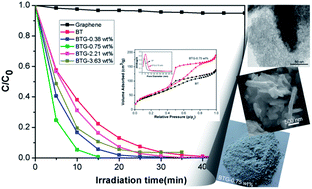Advanced visible-light-driven photocatalyst BiOBr–TiO2–graphene composite with graphene as a nano-filler†
Abstract
As a unique 2D carbon crystal with a zero bandgap nature, superior electron mobility and high transparency, graphene was introduced into BiOBr–TiO2 (BT) composites as a nano-filler by a facile one-pot approach to obtain a novel BiOBr–TiO2–graphene (BTG) ternary photocatalyst. The material exhibits superior photocatalytic activity towards the photodegradation of Rhodamine B under visible light irradiation, and has an enhancement in photocatalytic rate of up to 2.83-fold higher than that of the BT catalyst at an optimum content of 0.75 wt% graphene in the composites. The homogeneous hybrid colloids of BiNO3, tetrabutyl titanate and graphene oxide were employed as the precursor, while GO was reduced into graphene with a simultaneous formation of tetragonal BiOBr and amorphous TiO2 in the solvothermal process. The highly dispersed 2D graphene in the composites will not only serve as the electron reservoir, but also act as a conductive network to improve the migration efficiency of electrons. Furthermore, the spacer effect of graphene will increase the surface BiOBr concentration and decrease the crystal size of BiOBr, as well as facilitate the formation of relatively uniform channel-like pores, which is beneficial for the photocatalytic performance. The photodegradation in the BiOBr–TiO2–graphene system was carried out dominantly by an indirect dye photosensitization process and the superoxide radical anions ˙O2− were considered as the main reactive species. This work provides an in-depth perspective for understanding the graphene-involved photocatalytic mechanism and stimulates the design of novel catalytic materials for the exploitation and utilization of solar energy.


 Please wait while we load your content...
Please wait while we load your content...